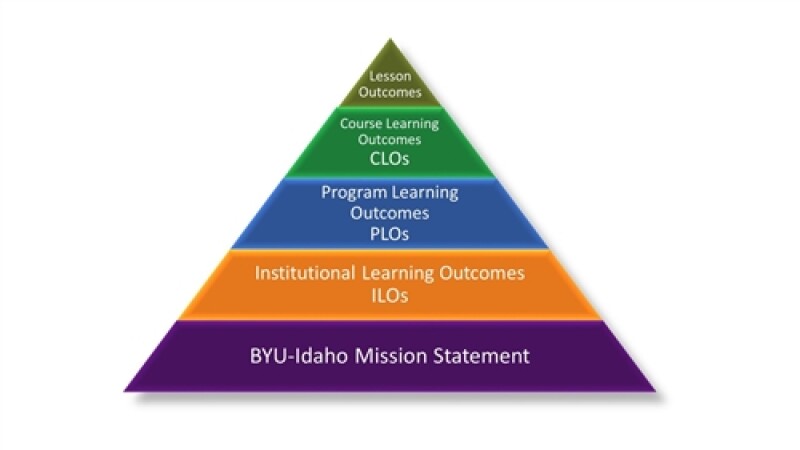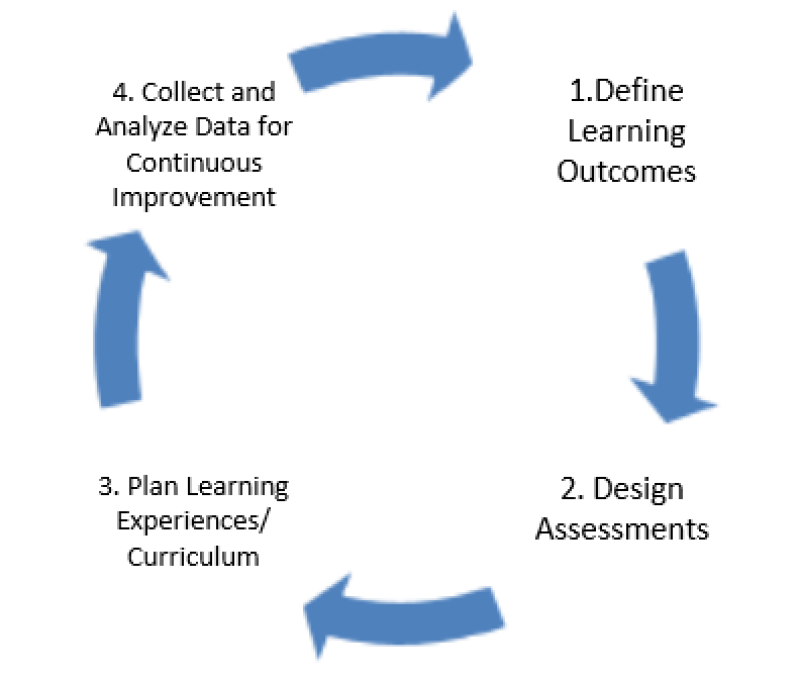Outcomes and Assessment

Outcome statements are used to define quality as it relates to student learning and development. Such outcome statements are defined at all levels of the university and go from very broad at the university level (i.e. students become lifelong learners as they...) to very specific at the course and lesson levels (i.e. students will be able to convert quantities of length from English to SI system).
Outcome statements at all levels of the university should contribute to and support the mission of the university. Responsibility for assessing student achievement of outcomes lies with faculty for course outcomes (CLOs), program leads and department chairs for program outcomes (PLOs), and university administrators for institutional outcomes (ILOs).
However, faculty, program leads, and university administrators must have a space to see how the different levels of outcomes integrate and align for the benefit and clarity of learning for students.
The continuous improvement cycle shown below can be used to improve student learning and achievement of outcomes at all levels. This document provides guidelines on how to implement this continuous improvement process.
Course Outcomes (CLOs) (Focus of Faculty)
Individual faculty members focus on student learning in their courses. This is where the primary assessment of student learning takes place.
One faculty member, Nadine Luke, meets frequently with students to observe their performance of the flute progress semester to semester. In order to ensure her introductory instruction and mentoring, she helps students study and practice the flute, she meets regularly with other faculty that teach higher levels of music theory in a sequence of courses.
Another faculty member consults with introductory course teachers to finalize and improve the sequence's impact on students through outcomes and assessment at both the course and program levels. Faculty members focus on improving student learning in their courses by doing the following:
Articulate Learning Outcomes:
Clearly articulate the desired learning outcomes for each course (i.e. what are the overall goals and purposes of the course from a student learning perspective).
Design Assessments:
Develop ways to measure student achievement for each outcome. This could be done using direct assessments (such as scores on exams or projects) as well as indirect assessments (such as student surveys or self-evaluations).

Plan Learning Experiences:
Develop the lessons, activities, experiences, and assignments that make up the course curriculum with the specific goal in mind of helping students achieve the course learning outcomes (CLOs).
Collect and Analyze Data for Continuous Improvement:
Collect the assessment data as planned. You may be asked to report a few key assessment results to your department chair.
For example, the department chair may ask for assessment results on a course outcome (CLO) that maps to a particular program outcome (PLO). The percentage of students who achieved various levels of proficiency on that course outcome could be reported in a format similar to that shown below.
a. The type and amount of assessment data that needs to be reported by faculty members is determined by the department chair or program lead.
b. Review the assessment results.
c. Look for indications of improved student performance that may have resulted from course changes in previous years.
d. Note these areas of improvement.
e. Look for areas in which the course could be improved further (whether in course outcomes, assessment activities, or learning experiences).
f. Document your plans for course improvement.
This type of course review and planning should be done by faculty members individually, but may also be part of an annual review with the department chair. This "review and plan" step is critical in the overall assessment process as it leads to action plans for improving student learning.

Program Outcomes (PLOs) (Focus of Department Chair/Program Lead)
Department chairs and program leads to focus on student learning at the program level. The purpose of program-level assessment is to help department chairs make informed decisions on the program curriculum and structure. Department chairs focus on improving student learning in their programs by doing the following:
Articulate Learning Outcomes:
Clearly articulate program-level learning outcomes (PLOs) (i.e. what are the overall goals and purposes of the program). List the courses that contribute to each program outcome. Indicate which university outcome (if any) each program outcome supports.
Design Assessments:
Develop ways to measure student achievement for each program-level outcome. Assessment at the program level should involve at least one measure from each of the following:
Direct assessments:
Direct assessments may include major field tests, professional exams, samples of course-level work (e.g. significant writing assignments, critical course-level exam results, capstone project evaluations), or other "direct" measures of student achievement.
Indirect assessments:
Indirect assessments may include senior exit surveys, student focus groups, alumni surveys, or other "indirect" measures of student achievement.

Plan Learning Experiences / Curriculum:
Learning experiences for program outcomes will occur primarily within courses. Courses that support each program outcome are already listed in item 1 above. Some programs may also use co-curricular activities to enhance student learning. These activities, along with the program outcomes they support, should be discussed.
Collect and Analyze Data for Continuous Improvement:
Collect the assessment data as planned. Where possible, report the data in terms of the percentage of students who met the program outcomes at the levels described below. If some of your assessment results do not match this format (as with certain types of indirect measures, for example), simply use an appropriate alternative format to summarize the results.
a. Review assessment results as a department.
b. Look for indications of improved student performance that may have resulted from a course or program change in previous years.
c. Note these areas of improvement.
d. Look for areas in which the program could be improved further (whether in program outcomes, program assessment activities, or program curriculum/course offerings).
e. Document your plans for program improvement (which may, in some cases, focus on a single program outcome).
The type of program review and planning described here should be done by departments at least annually in a department meeting or retreat. Results are reported each year in the department's Stewardship Review. In addition, Program Reviews are held periodically (every 3 years) with the University Curriculum Council (see Resource page).
Institutional Outcomes (ILOs) (Focus of Curriculum Council / Deans Council / University Administration)
The Curriculum Council and university administration focus on student learning throughout the university. One purpose of institutional-level assessment is to review student achievement in areas that are considered to be critical to a BYU-Idaho education. Another purpose of institutional-level assessment is to encourage faculty and departments to engage in the continuous improvement process that is inherent in the outcomes and assessment cycle.
The Curriculum Council and university administration focus on improving student learning across the university by doing the following:
Articulate Learning Outcomes:
BYU-Idaho Learning Outcomes (sometimes referred to as ILOs) (which are listed below) were developed by synthesizing common outcomes from academic programs across the university. The outcomes emphasize core competencies measured in each discipline across campus and in the BYU-Idaho General Education program.
- Disciples of Jesus Christ
- Sound Thinkers
- Effective Communicators
- Skilled Collaborators
- The intent of each outcome is clarified below:
- Students become Disciples of Jesus Christ as they believe in Jesus Christ as the Son of God and strive to follow Him.
- Students become sound thinkers as they frame and solve problems using creative and critical thinking.
- Students become effective communicators as they develop and express ideas that are purposeful, organized, and clear.
- Students become skilled collaborators as they work effectively with others to accomplish a shared vision.
Design Assessments:
Develop ways to measure student achievement for each institutional-level outcome (ILOs). Assessment at the university level involves both of the following approaches:
Direct assessments:
Direct assessments may include aggregating key program-level assessments (PLOs), along with compiling results of other assessment instruments such as the Collegiate Learning Assessment (CLA).
Indirect assessments:
Indirect assessments may include student surveys or focus groups, alumni surveys, etc.
Plan Learning Experiences / Curriculum:
Learning experiences for institutional outcomes occur primarily within courses and programs (although co-curricular activities may be used to enhance student learning as well). The way in which programs support each of the institutional outcomes (ILOs) could be shown in this Outcomes and Assessment PDF.
Collect and Analyze Data for Continuous Improvement:
Assessment data should be summarized in a way that facilitates discussion of student learning across the university. Key program-level assessment results, CLA results, and other assessment data should be summarized and published in an appropriate format.
Assessment results are reviewed by Curriculum Council and the university administration. Areas of strength and plans for improvement are noted. Improvement efforts could involve changes to the curriculum, new initiatives that focus on specific learning outcomes, etc.
Assessment results are communicated to the campus community, accreditation teams, and other stakeholders as needed.